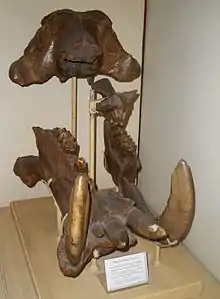Hippopotamus antiquus
Hippopotamus antiquus, sometimes called the European hippopotamus, was a species of hippopotamus that ranged across Europe, becoming extinct some time before the last glacial period at the end of the Pleistocene epoch. Some scholars classify it as Hippopotamus amphibius antiquus, a subspecies of the modern common hippopotamus, Hippopotamus amphibius.[2]
| Hippopotamus antiquus Temporal range: Late Early Pleistocene-Middle Pleistocene | |
|---|---|
 | |
| Hippopotamus antiquus in Florence Palaeontology museum | |
| Scientific classification | |
| Kingdom: | Animalia |
| Phylum: | Chordata |
| Class: | Mammalia |
| Order: | Artiodactyla |
| Family: | Hippopotamidae |
| Genus: | Hippopotamus |
| Species: | †H. antiquus |
| Binomial name | |
| †Hippopotamus antiquus | |
| Synonyms | |
| |
Chronology
In Italy, the first appearance of the taxon is during the late Early Pleistocene, around 1.2 Ma, the remains from Coste San Giacomo, suggested to date to around 2 Ma, have an uncertain stratigraphic context. The latest remains of the taxon date to MIS 15, indeterminate remains of hippopotamuses are found from MIS 15 to 9, after which remains attribuable to the living common hippopotamus are known.[3]
Biology
H. antiquus ranged from the Iberian Peninsula to the British Isles to the Rhine River to Greece.[4][5]

At an average weight of 3200 kg (7040 lb), Hippopotamus antiquus was larger than the modern common hippopotamus (Hippopotamus amphibius), but smaller than Hippopotamus major and Hippopotamus gorgops. H. antiquus is believed to have first appeared around 1.8 million years ago, compared to 2 million years ago for H. amphibius. Beginning in the Middle Pleistocene, H. amphibius migrated into Europe and may have competed with H. antiquus for food and water sources. [6]
The Cretan dwarf hippopotamus (H. creutzburgi) is believed to have evolved from H. antiquus through the process of insular dwarfism on the island of Crete.
References
- Desmarest, A.G., 1822. Mammalogie ou description des espèces de mammifères. Mme Veuve Agasse imprimeur édit., Paris, 2ème part., pp.277-555.
- Kurten, Bjorn (1968). Pleistocene Mammals of Europe. London: Weidenfeld and Nicolson. p. 156.
- Pandolfi, Luca; Petronio, Carmelo (2015-11-01). "Short remarks on the occurrences of continental Hippopotamus (Mammalia, Hippopotamidae) in Italy" (PDF). Geologia Croatica. 68 (3). doi:10.4154/gc.2015.24. ISSN 1330-030X.
- van Kolfschoten, Th. (2000). "The Eemian mammal fauna of central Europe" (PDF). Netherlands Journal of Geosciences. 79 (2/3): 269–281. Archived from the original (PDF) on 2011-07-24.
- "150 Years of Neanderthal Discoveries; Early Europeans - Continuity & Discontinuity," ed. von Koenigswald, Wighart and Thomas Litt, TERRA NOSTRA 2006/2 University of Bonn, in PDF Archived 2007-02-25 at the Wayback Machine
- Petronio, C. (1995): Note on the taxonomy of Pleistocene hippopotamuses. Ibex 3: 53-55. PDF fulltext Archived 2008-09-12 at the Wayback Machine